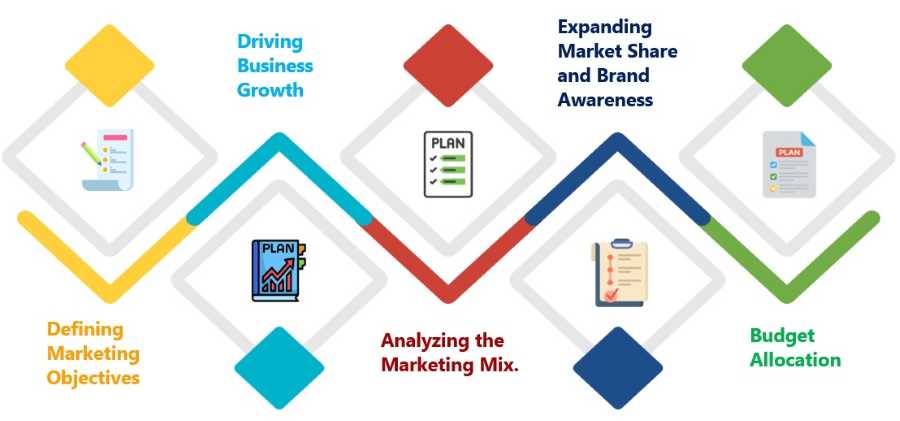Steps For Marketing Plan Preparation

A marketing plan serves as a strategic roadmap for businesses to organize, execute, and track their marketing strategies over a specific period.
It encompasses various marketing strategies employed by different teams within the company, all working towards the same business goals.
The primary purpose of a marketing plan is to outline strategies in an organized manner, helping to maintain focus and measure the success of campaigns.
By writing a marketing plan, you can establish the mission, target buyer personas, budget, tactics, and deliverables for each campaign.
Having all this information in one place facilitates staying on track and enables you to determine what works and what doesn't, allowing for the measurement of strategy success.

The purpose of a marketing plan includes the following:
- Defining Marketing Objectives: Clearly defining marketing objectives that align with the corporate mission and vision of the organization, indicating where the organization aims to be in the future.
- Driving Business Growth: Assisting in the growth of the business by outlining appropriate marketing strategies, such as plans for increasing the customer base.
- Analyzing the Marketing Mix: Evaluating and reviewing the marketing mix in terms of the 8Ps of marketing - Product, Price, Place, Promotion, People, Process, Physical Evidence, and Performance.
- Expanding Market Share and Brand Awareness: Developing strategies to increase market share, enter new niche markets, and enhance brand awareness.
- Budget Allocation: Detailing the budget required for implementing the activities outlined in the marketing plan.
Components of Marketing Strategy:
- Marketing Mix: The marketing mix, also known as the 4 Ps of marketing, is a fundamental document used to understand what will be marketed, where it will be marketed, and how it will be marketed.
It consists of the following elements: Product, Price, Place, and Promotion.
- Marketing Objectives: Setting marketing objectives either in conjunction with the 4 Ps or as a separate step. These objectives guide other components of the plan and inform budget allocation and content creation.
- Marketing Budget: Allocating funds to essential elements of the strategy, such as hiring the right talent, using suitable software, advertising on relevant channels, and creating compelling content.
- Competitive Analysis: Conduct a thorough analysis of competitors to differentiate oneself effectively and capture the attention of the intended audience.
- Forecasts: Forecasts are a fundamental part of planning as they are predictive of future trends and scenarios.
They shed light on potential opportunities and challenges that may arise in the future. By forecasting, a company can reduce risks and take advantage of opportunities that promise the best results.
Timely and informed decisions can be made based on forecasts related to future customer demands, raw material availability, competitors' strategies, economic climates, and government policies.
- Policies: Policies serve as guidelines for achieving a company's set objectives. They provide direction to managers, administrators, and employees about the appropriate course of action in given situations.
They represent the fundamental principles through which objectives are pursued.
- Procedures: Procedures offer a roadmap for executing marketing activities. They comprise a series of tasks that must be carried out systematically to attain certain objectives.
Marketing procedures ensure that marketing practices are implemented in an organized and orderly manner.
- Programs: A marketing program is a strategic plan that leverages all elements of the marketing mix to achieve specific marketing objectives. This plan is designed following the organization's policies, procedures, and targets.
Programs can be created to address various aspects such as advertising, promotion, pricing, distribution, and product design.
- Schedule: A schedule details the timing and duration of specific tasks. It is essentially a plan that outlines the sequence and allocated time for each constituent part of a project.
The schedule delineates the actual start time of a marketing project, the order of operations, and the time frame within which each task should be completed. This ensures the overall project is executed within the stipulated period.

Marketing Planning Process
1. Scanning the Marketing Environment: Assessing the external factors and identifying business opportunities and potential threats.
2. Internal Scanning: Evaluating the firm's strengths, weaknesses, core competencies, and competitive advantages.
3. Setting Marketing Objectives: Establishing clear objectives in areas such as sales volume, market share, innovation, productivity, and profit based on the opportunities available and the firm's resources and capabilities.
4. Formulating Marketing Strategy: Developing a set of objectives, policies, and rules that guide marketing efforts over time, providing a comprehensive plan for achieving marketing objectives.
5. Developing Functional Plans: Elaborating on the marketing strategy by creating detailed plans and programs that align with the marketing objectives and overall strategy of the firm.
Benefits of Marketing Planning:
1. Marketing planning promotes successful marketing operations.
2. Planning helps to co-ordinate activities which can facilitate the attainment of objectives over time.
3. It forces management to reflect upon the future in a systematic way.
4. Resources can be better balanced in relation to identified market opportunities.
5. A plan provides a frame work for a continuing review of operations. It will make the firm to give more attention to market enlargement rather than market maintenance.
Please feel free to share your comments in the comment box below if this well-researched post has given you some new information.
Author Bio
This user has not submitted a user bio yet
Article Comments
No Comments!
At present there are zero comments on this article.
Why not be the first to make a comment?
Similar Articles
Sponsor
Search Articles
Experts Column
Latest Articles
Featured Articles
Most Popular Articles












